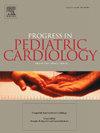Supraventricular tachycardia in children
IF 0.6
Q4 PEDIATRICS
引用次数: 0
Abstract
Background
Supraventricular tachycardia (SVT) affects 1 in 500 children and is characterized by rapid heart rate originating from the atrial tissue above the atrioventricular node and interventricular septum.
Aim of review
The purpose of this article is to review the etiology, pathophysiology, types, clinical presentation, diagnosis, and treatment of SVT in children.
Key scientific concepts of review
SVT results from reentry circuits, abnormal automaticity, or triggered activity. Contributing factors include congenital heart defects, electrolyte imbalances, and genetic predisposition. The types of SVT include atrioventricular nodal reentrant tachycardia, atrioventricular reentrant tachycardia, atrial tachycardia, and junctional ectopic tachycardia. Infants with SVT may present with poor feeding, vomiting, irritability, increased sleepiness, syncope, or diaphoresis. Toddlers and school-aged children may experience palpitations, chest pain, dizziness, shortness of breath, or syncope. Diagnostic tests include the electrocardiogram, Holter monitor, exercise stress test, and electrophysiologic study. Acute treatment options include vagal maneuvers, pharmacologic cardioversion, and electrical cardioversion. Long-term treatment options include antiarrhythmic drugs, catheter ablation, and surgical treatment. Complications of SVT include hemodynamic instability, thromboembolic events, congestive heart failure, exercise limitation, and decreased quality of life. Special considerations include missed diagnosis in neonates and infants, the association of SVT with congenital heart disease, and transition of care from pediatric to adult cardiology. Future directions and research may include advancements in genetic and molecular biomarkers and ablation methods. It is important to provide education and counseling to patients and their families, including information about the condition, treatment options, potential complications, and psychological support.
求助全文
约1分钟内获得全文
求助全文
来源期刊

PROGRESS IN PEDIATRIC CARDIOLOGY
PEDIATRICS-
CiteScore
0.90
自引率
11.10%
发文量
69
审稿时长
75 days
期刊介绍:
Progress in Pediatric Cardiology is an international journal of review presenting information and experienced opinion of importance in the understanding and management of cardiovascular diseases in children. Each issue is prepared by one or more Guest Editors and reviews a single subject, allowing for comprehensive presentations of complex, multifaceted or rapidly changing topics of clinical and investigative interest.
 求助内容:
求助内容: 应助结果提醒方式:
应助结果提醒方式:


